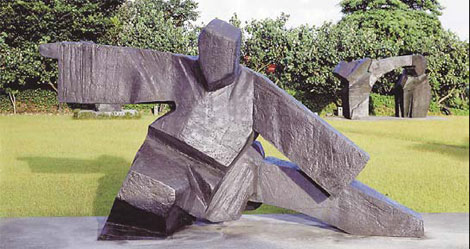In this life and the next
 |
|
Single Whip from the Tai Chi series, copper, by Ju Ming. [China Daily] |
Ju's first solo exhibition was held in March 1976 at the National Museum of History in Taipei, thanks to Yang, who convinced the museum authorities to show his student's pieces.
The works displayed at the exhibition included sculptures of water buffaloes, an important symbol of Taiwan's country life, and historical and legendary figures, rendered in a rustic and simple manner.
With their articulate forms and sincere expression of feelings, the sculptures had a power and charm that immediately captured the attention of the local art community and media.
As a result, Ju became a prominent figure in the back-to-the-roots movement of the late 1960s and 1970s, when artists in Taiwan began saying no to the idolization of Western-style art and started looking for something more in touch with their life and culture.
But, despite his unprecedented success with native imagery, Ju was not content.
Ju had begun practicing tai chi, on Yang's advice, in order to develop physical and mental discipline. He believes he benefited immensely from this practice and gradually started thinking about sculpting works on the theme of tai chi, which had never been done before.
More abstract than his previous native-flavored works, his Tai Chi series consisted of large, monumental wood and bronze sculptures.
He carefully studied each movement and posture of tai chi before he rendered them, fully expressing in simple forms tai chi's spirit of calmness, stability and strength.
The Tai Chi series garnered rave responses from foreign viewers when shown abroad, but provoked harsh criticism at home. People impressed with his previous works, scolded him as "having stepped away from tradition".
However, the criticism did not stop him from seeking new challenges.
"I can take tai chi only so far I like to innovate. When I sculpt tai chi, the postures and spirit of tai chi must always be brought out. This means than I am not given free reign," Ju later explained.
Just like his Tai Chi works, each figure in the Living World series is minimalist - a carved line for a nose, two for the eyes, a circle for a mouth. Yet every character seems to be alive and telling a different story of modern-day living.
Tai Chi and the Living World series have earned Ju a worldwide reputation and pronounced him a master of figurative art, noted art collector and curator Chang Tsong-zung says.
Ju has forged a sculptural language of his own. And with the ever-transforming appearances in the Living World series "came multiple breakthroughs in terms of external artistic morphology", Taiwan art critic I-ming Chen says.
Meanwhile, Ju has continued to make his art more inclusive and conceptual. His latest Imprisonment works deal with the subtle distinction between good and evil, other-imprisonment and self-imprisonment, freedom and its limits. As Ju himself proclaims: "I will keep working on the Living World series until I grow old, because it is so interesting and there is so much to present. In fact, I will want to keep doing it even in my next life."
 0
0 







Go to Forum >>0 Comments